TRINDADE, Fábyla d’ Tácia Brito [1]
GOMES, Nathalia Neves [2]
FERREIRA, Sandra Elizia Gonçalves [3]
MORAIS, Elisângela Claudia de Medeiros [4]
OLIVEIRA, Margaret de [5]
DENDASCK, Carla Viana [6]
OLIVEIRA, Euzébio de [7]
TRINDADE, Fábyla d’ Tácia Brito; et.al. Prevalence of Depressive Symptoms in Nursing Academics of a Private School in Belém-PÁ. Multidisciplinary Scientific Journal. Special Edition of Health. Year 02, Vol. 04. Issue 11, pp. 24-38, November of 2017. ISSN:2448-0959
ABSTRACT
The purpose of this article was to identify the prevalence of depressive symptoms in nursing students in the 1st, 4th and 8th periods of a private college in Belém-Pa. Exploratory quantitative approach research and the instrument used was the Back-ll Depression Inventory. In a sample of 147 academics, 69 (46.94%) did not present depressive symptoms, 42 (28.57%) presented mild symptoms, 31 (21.08%) presented moderate symptoms and 5 (3.40%) had severe symptoms . Most academics presented indicative of mild to moderate depression symptoms. A greater change was observed in the results of the 8th period, which, to a certain extent, is in agreement with other studies carried out with students of the health area, for this phase of the course. It is also important to highlight a high index of symptoms of severe depression in the first period. From the results obtained, it was possible to observe the need for psychological attention to nursing students of all periods, aiming to offer support to deal with situations of psychological distress.
Keywords: Depression, Nursing Course Academics, Beck II Depression Inventory.
INTRODUCTION
Depression “a disease of the present time” this term has been widely used in scientific circles and disseminated in the media. Initially, the symptoms of sadness, anxiety, and suicidal tendencies were called melancholy. A term created more than 25 centuries ago, designated symptoms or characterized mental states. From the seventeenth century onwards, there were several transformations, among them the replacement of the term melancholia with depression and psychiatry emerged as a medical specialty. Throughout the twentieth century, several terms have been studied and debated, such as the question of the endogenous or exogenous nature of depression and the unipolar and bipolar terms. Perhaps the most striking of the changes has been to consider depression as a disease or affective or mood disorder (MAXWUELL, 2010).
Generally, this disease consists of a universal mental disorder, whose main disturbance is the change of the humor or the affection. The mood swings reflect negatively on all activities of the affected person. Loss of productivity, loss of interest and lack of initiative both at work and in the study, are symptoms that cause serious social harm to the patient. In the face of these syndromes, Depression is considered a public health problem. In the twenty-first century, depression has been responsible for the highest burden of disease among those characterized by mental disorder. The overload is not only for the individual who suffers, but also for their relatives and caregivers (MOREIRA; FUREGATO, 2013).
The World Health Organization estimates that there are 350 million people living with depression in the world and is expected to affect more people than any other health problem in the coming years, including cancer and heart disease. Depression usually has a high cost, not only in financial terms, but can also cost relationships, jobs, and even life itself (BEES, 2014).
In Brazil data from the Brazilian Institute of Geography and Statistics (IBGE) show that depression is the fourth most diagnosed chronic disease, followed by hypertension and cancer. About 42% are assisted in private practices and 33.2% use the basic health unit, generating high economic and social costs for the Government (IBGE, 2013).
A population that deserves attention, because it is in contact with the psychic suffering, is that of students and health professionals. This part of society is constantly marked by uncertainties and anxieties, which must be carefully considered, since when they are experienced, they reveal their own feelings, as well as the difficulty in managing them. These situations provoke a shock reaction between the “good” and the “bad”, generated mainly by the anguish resulting from the individual’s maladaptation in the face of a new situation (OLHER, 2012).
WHO data reveal that depression is a public health case in all regions of the world. Studies show that half of Brazilian university students experienced some type of emotional crisis in 2011, where depression was the most representative: reaching about 15% of students (SIMAS, 2012).
In view of this situation, we present this work that aims to highlight the importance of identifying the prevalence (number of cases in a given population) of depressive symptoms among the academics of the Amazon Metropolitan College (FAMAZ), and to alert need to elaborate actions that aim to offer greater care and guidance so that the student can deal with the psychic problem.
MATERIAL AND METHODS
The present study is a research of quantitative approach of exploratory character.
The instrument applied was the Beck II – BDI-II Depression Inventory. Refers to sadness, pessimism, past failure, loss of pleasure, guilt, feelings of punishment, self-esteem, self-criticism, suicidal thoughts or desires, crying, agitation, loss of interest, indecision, devaluation, changes in sleep patterns, irritability, appetite changes, concentration difficulties, fatigue or fatigue, and loss of interest in sex (Finger, 2008).
The BDI consists of a self-report questionnaire with 21 premises, referring to the current moment of the subject and quantified in a scale of 4 intensity points (0 to 3). The purpose of this scale is to evaluate the symptomatology of depression. It is an instrument of easy manipulation and application, besides having great acceptance. Scores range from zero to 63, where zero indicates no trace of depressive symptoms, while the higher score indicates greater severity of symptoms. The interpretation guide is as follows: (a) 0 = no depression; (b) 10 to 16 = indicates a state of mild depression; (c) 17 to 29 = comprises a state of moderate depression; and (d) 30 to 63 = indicates a state of severe depression. BDI can be applied in individuals aged 13 years or over (Finger, ARGIMON, 2013).
The research was carried out at the Metropolitan Amazonian Faculty (FAMAZ), which is a private higher education institution integrated to the Euro-American Educational Group, based in Belém do Pará, Brazil, with students from the 1st, 4th and 8th nursing courses ° periods.
Initially a pre-contact was made with the coordination responsible for the nursing course to authorize the data collection of our research.
The research was submitted to the approval of the research ethics committee (CEP), institutional consent and signing of the informed consent form, which were clarified about the objectives of the study and acceptability in participating in the research, of the instrument. The data collection was done in classrooms, at a schedule previously scheduled with the students and teachers and with the consent of the course coordination.
RESULTS
The research was carried out in September 2015, with students of the first, fourth and eighth periods, the afternoon and evening shifts of the Nursing Course of the Amazon Metropolitan College (FAMAZ). The total number of academics enrolled in the course and who are regularly attending the above mentioned periods is 217, of these 147 participated, 57 were not in college, 13 refused to participate in the application of the Beck – IDB Depression Inventory.
More than 53% of the participants presented symptoms of depression, of which 28.57% presented symptoms of mild depression, 21.08% had symptoms of moderate depression, and 3.40% presented severe depression. (Table 1).
Table 1. Classification of symptoms among research participants (2015)
| IDB | Absolute Frequency | Percentage Frequency | Cumulative frequency |
| No Depressive Symptoms | 69 | 46.94% | 100% |
| Light Symptoms | 42 | 28.57% | 53.05% |
| Symptoms Moderate | 31 | 21.08% | 24.48% |
| Severe Symptoms | 5 | 3.40% | 3.40% |
| TOTAL | 147 | 100% | – |
Characteristics of participants
The majority of participants (56.46%) were young adults, aged up to 29 years (RCT, 2013). Regarding the gender of the participants, the highest trend was female (F) with 85.03%, which corresponds to more than five women for each man (M) of the course, considering the ratio (F / M) of 5 , 68. The variation in the age of the men is between 18 and 48 years, with a mean of 27.81 years and a standard deviation of 9.07, while the female is between 17 and 53 years, with a mean of 28.18 years and deviation standard of 8.29.
Most of the research participants do not practice nursing technician activity (58.5%). The distribution of participants per semester was balanced, considering the afternoon and evening shifts, with 30.61% of participants in the first period, 38.77% of fourth period students and 32.65% of students in the eighth period (Table 2) .
Table 2. Descriptive analysis of the characteristic data.
| SEX | Frequency
Absolute |
Frequency
Percentage |
| MALE | 22 | 14.96% |
| FEMALE | 125 | 85.03% |
| AGE IN YEARS | ||
| 17 to 29 | 83 | 56.46% |
| 30 to 55 | 64 | 43.54% |
| PERIODS | ||
| FIRST | 45 | 30.61% |
| BEDROOM | 57 | 38.77% |
| EIGHTH | 48 | 32.65% |
| WORK AS A TECHNICIAN | ||
| YES | 61 | 41.5% |
| NO | 86 | 58.5% |
Analysis of IDB-II
The exploratory analysis of the factors investigated in the study showed that the score obtained in IDB II is higher for the participants considered young who are between 17 and 29 years old compared to those who are aged between 30 and 54 years. (Graphic 1).
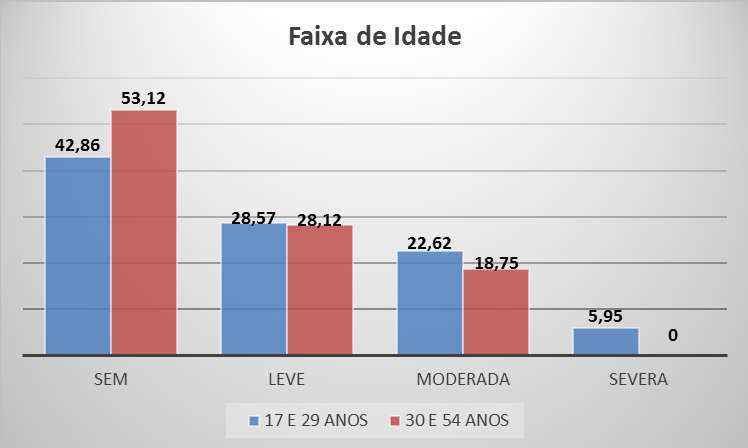
The classification of the degree of depression of working students and those who do not work as a Nursing Technician, according to symptoms of IDB II, is shown in figure 2, where it is highlighted that depression at a severe level affects 27.87% of the interviewed who work as nursing technicians.
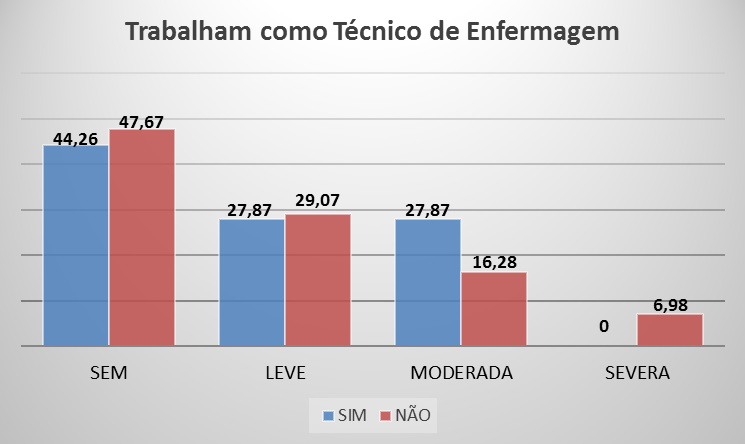
Depressive symptoms and their severity
The analysis of the score obtained in each semester in IDB II showed that in the 1st period of the course, (29) 58.13% of the students did not present depressive symptoms; (9) 20.93% were classified as having mild depression symptoms; (6) (13.95%) presented symptoms compatible with moderate depression and 3 (6.98%) with symptoms of severe depression. (Graph 3).
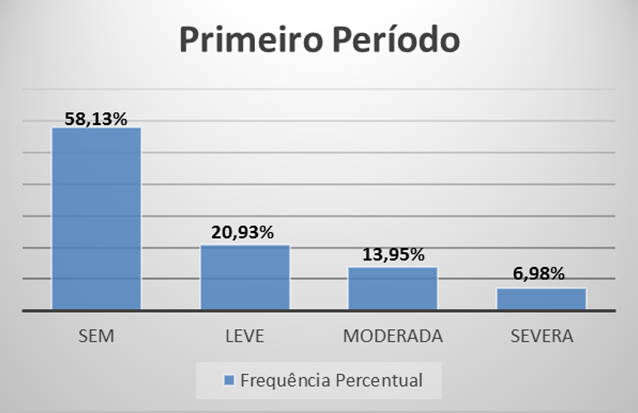
Among the 4 th semester students, the majority (25) 43.86% did not present depressive symptoms, whereas (19) 33.33% were classified as mild symptoms, (12) 21.05% with moderate symptoms and 1 academic (1 , 75%) with severe symptoms. (Graph 4).
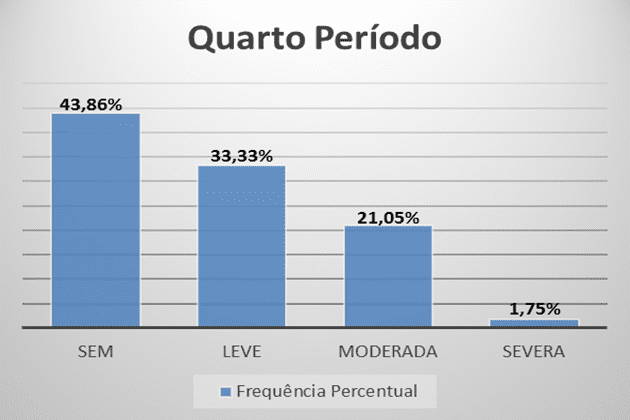
The score obtained by the academics of the 8th period was as follows: (19) 40.42% without depressive symptoms; (10) 29.79% with mild symptoms; 13 (27.66%) with moderate depression and (1) 2.12% were classified as having severe depression symptoms (Graph 5).
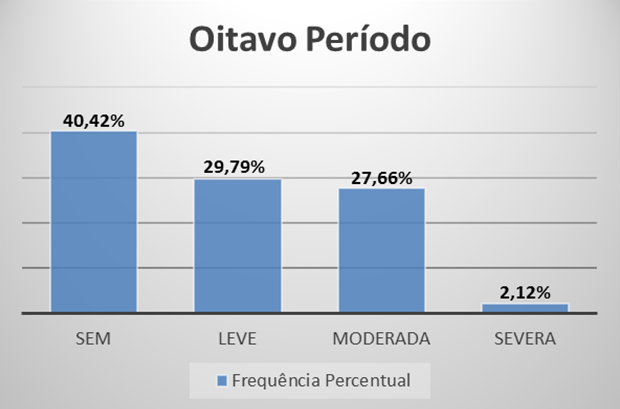
DISCUSSION
This research was aimed at identifying the prevalence of depression symptoms and other associated factors among students of the first, fourth and eighth periods, of the afternoon and evening shift of the nursing course. Considering the cutoff points for IDB II, (69) 46.94% did not present symptoms of depression and (42) 28.57% had mild symptoms. The accumulated frequency totals 75.51% of the students who would be in a regular situation. However, we should highlight the 24.48% of the students with indicative symptoms of moderate depression (32) 21.08% or severe (5) 3.41%, which represents an index higher than other studies as in Furegato (2013).
According to Simas (2012), half of Brazilian university students experienced some kind of emotional crisis, with depression being the most representative, affecting about 15% of students. When the population is considered between 20 and 40 years of age the prevalence index of depression is around 25%. Considering these results, it is observed that the values obtained in the research (24.48%), are close to the indexes of these studies.
The result of the research showed a predominance of female students in the course (125) 85.03%, which made it impossible to compare the male sex (22) with 16.97%. Despite this dominance, we can not fail to consider the IDB II score of female participants with moderate (24.48%) or severe (3.40%) depression, which is significant and worrying. These data are in accordance with the work of Rezende et al (2008), which shows a higher frequency of depressive symptoms in women, both in the academic and general population.
According to research by Rezende et al (2008), women present about twice as much depression as men. However, being female does not mean being a risk factor, it is necessary to consider the cultural reality, the time and the social role of the woman, so that we can understand these indices. According to Deperon et al (2013), the difference can also be observed as a consequence of women’s psychosocial and biological factors.
As to the age of the students, there was a higher frequency (56.46%) of young students aged between 17 and 29 years, while in the age range of 30 to 54 the rate was 43.54%. Also, a relationship between age and BDI-II scores was observed, younger students presented a higher indicative of symptoms of depression, considering the moderate (22.62%) to severe (5.95% ). This fact is justified by Rezende et al (2008) when it reveals that university students in general are more susceptible to emotional changes due to the social situation to which they are subject, since they feel biologically mature to be socially adult, have teenage status because they experience a long ritual of initiation before being released for the roles they are intended for.
In relation to the periods studied, it was observed that mild, moderate and severe symptoms are present among the students of the three periods. Significant data were observed in the first period, presenting a high index (6.98%) of severe symptoms. Oliveria (2013) observes that higher prevalences at the extremes of the course can be explained by the behavioral phases that the students experience during graduation. In this case, the results are justified by the initial state of euphoria, by the change of lifestyle and high demands of the disciplines.
As the student progresses in the course, the rate of students without depressive symptoms decreases and values for moderate depressive symptoms increase, even when there is a difference between the 4th and 8th period in relation to severe symptoms, which reveals a consonance with other studies. Finger and Argimon (2013) show that students in the final phase of the course are moderately stressed and argue that the transition from academic to professional life, accompanied by increased tasks and responsibilities, arouses tension and anxiety in academics. Increasing the workload of studies and internships places the student in conditions of greater vulnerability. Leaving the protected academic environment and facing the new challenges can lead to stress and, consequently, emotional imbalance and states of depression.
CONCLUSION
The results indicate that the study population was of young adults, in the age group between 17 and 29 years old. The study population deserves significant attention, since in the total of 147 undergraduate nursing students, more than 78 (53%) of the participants presented symptoms of depression, and 5 (3.40%) of them had symptoms indicative of severe depression and does not exercise as a nursing technician.
The IDB II allowed us to detect the presence of depressive symptoms in nursing academics of the institution, so we can observe the need for family support, social and psychological support for academics.
With the results we suggest the institution to the implantation of psychological support, educational programs, clinical strategies for orientation, preventive measures and projects of support to the academics, with the objective of providing support to deal with the situations inherent to academic life, quality of life personnel and the training of these future professionals, thus preventing possible depressive disorders or even initiating an early diagnosis.
There was a difference between the rates of depressive symptoms also between the sexes, with women presenting higher rates than men.
The research with nursing students made it possible to analyze depressive symptoms and the possible relations with the academic formation. The results allowed to evaluate the academic formation the presences of depressive symptoms varied according to the period and the semester in which the students were inserted.
Finally, it is believed that the results of this research represent advances and may help the coordination of the nursing course with the proposition of intervention actions in the curricular structure and academic everyday life.
There are still few studies that investigate nursing students. In this sense, it is suggested the development of other researches in order to establish comparisons with this one to study it more productive and less exhausting.
It was verified through the developed study that the depressive disorders generate symptoms that compromise the individuals, independently of the age group, in their social and familiar relations, as well as in the academic development, with alterations in the way of thinking, mood swings and behavior.
In view of the above, it is important to study more and more about the symptoms.
REFERENCES
BEE, Lúcia. Depression, a public health issue. Cad. Health collection. v. 22, n. 3. Rio de Janeiro 2014. Available at: <http://dx.doi.org/10.1590/1414-462X201400030001>. Accessed on: 04 Mar. 2015.
ARGIMON Irani I. de Lima Instruments for the Evaluation of Depressive Symptoms – Stricto-Sensu Post-Graduation Program in Psychology, São Francisco University 2011. Available at: <http://www.ibapnet.org.br/congresso2011/trabalhos/4068.pdf> Accessed on: 07 Mar. 2015.
BEST DOCTOR. According to the WHO, depression is the main cause of disability. 2010 Available at: <http://www.bestdoctorsblog.com/en/second-a-second-support/> Accessed on: 26 Apr. 2015.
CAMARGO Raquel de M. et al. Prevalence of cases of depression in nursing students at a teaching institution in Brasília, 2012.
DEPERON Carolina de O et al. Depressive behavior in nursing students. 2013. Available at: <http://www.abeneventos.com.br/anais_senpe/ 17senpe / pdf / 0669po.pdf> Accessed on: 11 apr. 2015.
APA – American Psychiatric Association. DSM-5. 2013. Available at: <http: // www. dsm5.org> Accessed on: 04 Mar. 2015.
METROPOLITAN AMAZON COLLEGE – FAMAZ. Available at: http://www.famaz.edu.br/portal/a-faculty/. Accessed on 25 Apr. 2015.
FINGER, Igor da Rosa; ARGIMON, Irani Iracema L. Psychometric Properties of the Beck-II Depression Inventory (BDI-II) in a university sample. Journal of Psychology, IMED, v. 5, p. 84-91, Jul-Dec, 2013.
FINGER, Igor da R. Beck-II depression inventory construct validity (BDI-II) in a university population. Porto Ale[S.n.]gre:.
HORTA M. Depression: Disturbed minds. Super Interesting Magazine. Issue 290. São Paulo: Editora Abril S / A. 2011.
BRASILEIRO INSTITUTE OF GEOGRAPHY AND STATISTICS – IBGE. Available at: <http://www.ibge.gov.br/home/estatistica/populacao/pns/2013/default.shtm> Accessed on: 26 apr. 2015.
LAKATOS, E. M .; MARCONI, M. A. Methodology of scientific work. 7. Ed. Sao Paulo. Atlas. 2010
MAXWUELL. Melancholy and depression in history. PUC – Rio. 2010 Available at: <http://www.maxwell.vrac.puc-rio.br/8580/8580_3.PDF.> Accessed on: 02 mai. 2015.
MY LIFE. Depression. Available at: <http://www.minhavida.com.br/ health / themes / depression>. Accessed on: 05 May. 2015.
MOREIRA, Daniela Perpétua; FUREGATO, Antónia Regina F. Stress and depression among students of the last period of two nursing courses. Rev. Latino-Am. Nursing[Internet]. jan.-feb. 2013. 2014. Available at: <http://www.eerp.usp.br/rlae.> Accessed on: 21 Dec.
OLHER, Rayssa F. Studies on depression in nursing students. Rev Enferm UNISA. v.13, n. 1, p. 48-52, 2012. Available at: <http://www.unisa.br/graduacao/ biologicas / enfer / revista / archives / 2012-1-08.pdf.> Accessed on: 29 nov. 2015.
WORLD HEALTH ORGANIZATION – WHO. Available from <http://www1.folha.uol. com.br/equilibrioesaude/2014/12/1563458-depressao-ja-e-doenca-more-incapacitante-firma-a-oms.shtml>. Accessed on 23 Apr. 2015.
SILVA, Dirceu da; LOPES, Evandro Luiz; BRAGA, Sergio S. Quantitative Research: Elements, Paradigms and Definitions. Cover, v. 5, n. 1, 2014.
SILVA, V. L. S. et al. Stress factors in the last year in the undergraduate nursing course; Perception of students. Journal of Nursing UERJ. n. 15, p. 121-126, 2011.
SIMAS, Anna. Depression has high rate among students. Gazeta do Povo. 2012. Available at: <http://www.gazetadopopo.com.br/educacao/vida-na-universidade/depression-tem- high-rate-between-students-2oyhrf8hrqh5aqwrfccac0ci6>. Accessed on: 04 May. 2015.
STELLA, Florindo; GOBBI, Sebastião; CORAZZA, Danilla Icassatti; COSTA, José Luiz Riani. Depression in the Elderly: Diagnosis, Treatment and Benefits of Physical Activity. Motriz, Rio Claro, Aug / Dec 2002, Vol.8 n.3, pp. 91-98
TOLEDO Wagner Luiz G. Depression: body, mind and soul. 3. ed. Uberlândia – BH. 2010 Available at: <http://www.ebooksbrasil.org/adobeebook/depressaocma.pdf>. Accessed on: 16 Jan. 2015.
[1] Nurse graduated from the Amazon Metropolitan College (FAMAZ).
[2] Nurse graduated from the Amazon Metropolitan College (FAMAZ).
[3] Nurse graduated from the Amazon Metropolitan College (FAMAZ).
[4] Psychologist. Master in Theory and Behavior Research. PhD student in Tropical Diseases at the UFPA Tropical Medicine Center (NMT-UFPA). Lecturer at the State University of Pará – UEPA.
[5] Registered Nurse and Bachelors in Nursing Science. USA – California.
[6] PhD in Clinical Psychoanalysis, Researcher at the Center for Research and Advanced Studies.
[7] Biologist. Doctor of Medicine / Tropical Diseases. Professor and Researcher at the Federal University of Pará – UFPA. Researcher at the Laboratory of Human and Environmental Toxicology and in the Laboratory of Oxidative Stress of the Nucleus of Tropical Medicine of UFPA (NMT-UFPA).















